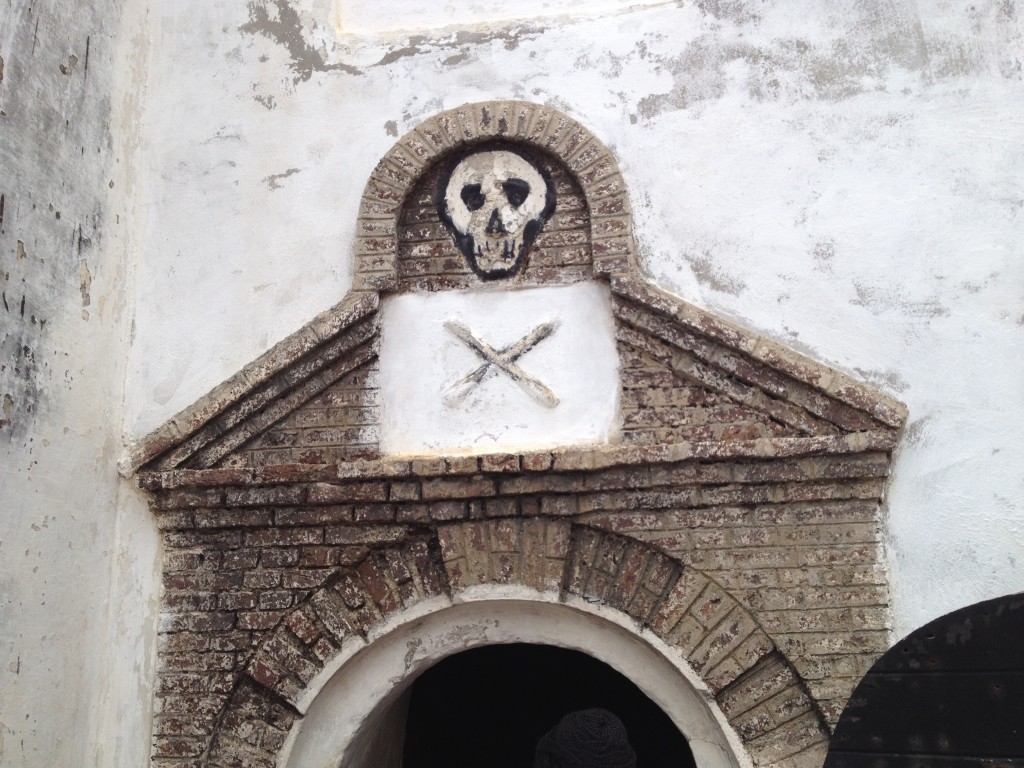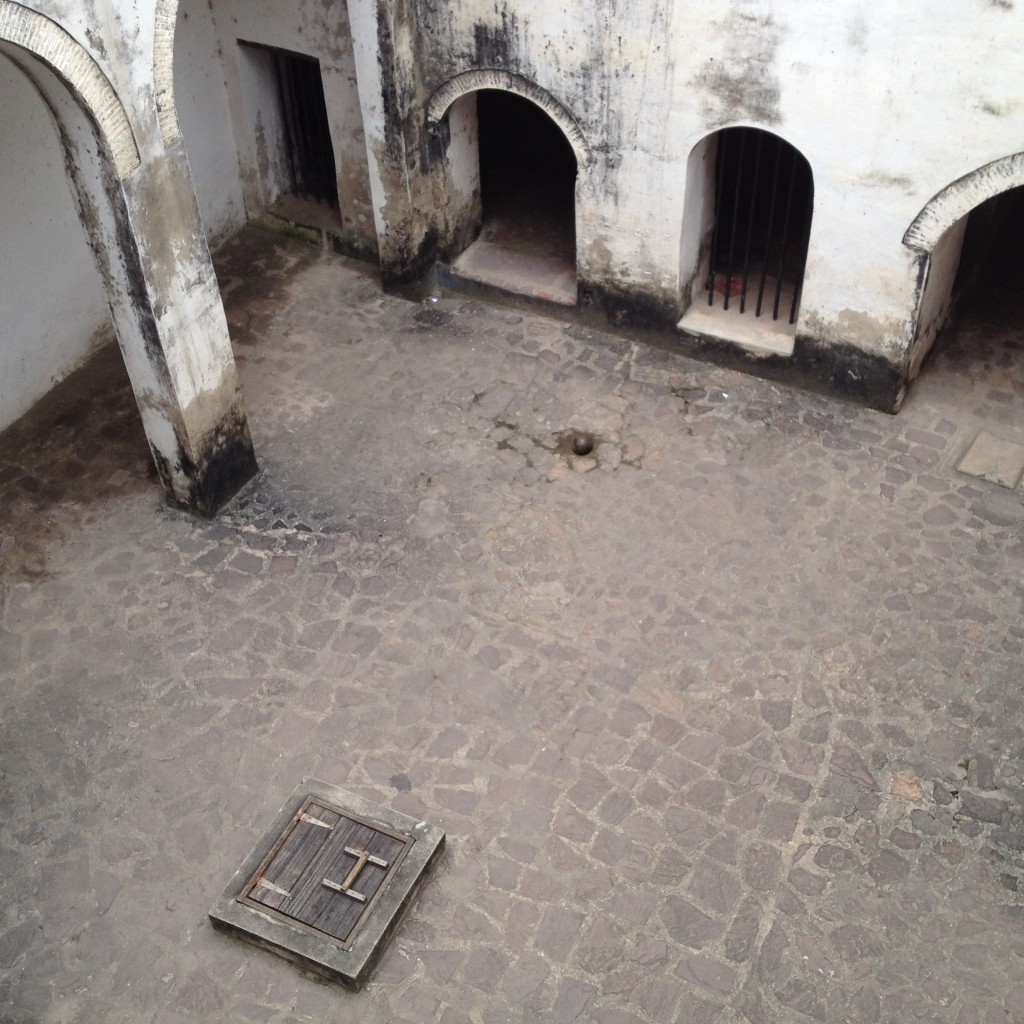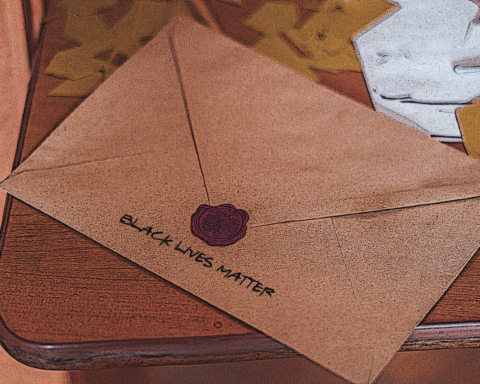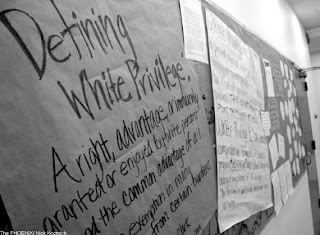
In September 2015, about 70 Presbyterian and Reformed African women church leaders came together in Accra, Ghana, for the third Tumekutana Conference. Our theme was “Freedom in Christ: From Slavery to Empowerment” based on Luke 13:12 “Woman, you are set free…”
As part of the conference we took a field trip to the Elmina Slave Castle. We walked through the crowded village with a sense of anticipation, not know exactly where we were going or what we would find. Then, there it was in front of us, a large, imposing building. We crossed a bridge over what appeared to be a moat and walked through a dark, cool tunnel-like entryway before we emerged into the bright sunlight of the main courtyard of the castle.
A little background: Elmina Castle was built by the Portuguese in 1482 and operated from that year as a center for trade in gold and ivory. This quickly went on to include trade in slaves. In 1637, the Dutch took over and held the Castle until it was taken over by the British in 1872. (The Dutch, in the meantime, had outlawed the slave trade in 1814.) It is estimated that each year, 30,000 people were transported as slaves from Elmina to the New World. Of those who were captured into slavery, about 30% died either on the march to the coast or while being held waiting for the transport ships. Another roughly 15% died during the passage.
___________________________________________
We, both African and non-African, had read about the slave trade in our history books, but seeing this in person was beyond anything that we had ever imagined.
___________________________________________
In the central court yard we saw a plaque commemorating a governor who had died in office. Part of the priest’s eulogy was imprinted on the plaque, stating among other things that “[the governor] was a good man.” We saw other signs showing that the holders of the castle considered themselves Christians. Across from the plaque in the main courtyard was a church, and in another room a Bible passage was engraved above the door frame.

As we were led through the castle, we entered into a dungeon that was a punishment cell for the Europeans, solders and others in need of correction. Although it was not pleasant, the cell did have light and air circulation, and our guide informed us that those who spent time in this dungeon were not kept there for long.
The next room we entered, right next door, was the punishment cell for ‘recalcitrant’ African men. The group of us crowded in and the door was closed behind us. There was no air and no light. Many of us sensed a real horror in the few seconds that the door was closed. When the door was opened and our hearts started returning to their normal rhythm, our guide explained that those who were thrown in this cell were given neither water nor food and were removed only once they had died.
___________________________________________
Up to 200 women were crowded into each of the rooms, we were told, so many people that lying down was impossible.
___________________________________________

The next set of dungeons we visited were the women’s dungeons. Here were 4 or 5 cells facing onto another smaller courtyard. Up to 200 women were crowded into each of the rooms, we were told, so many people that lying down was impossible. Looking around the courtyard, we could see a cannon ball, a wooden trapdoor on the floor, and an open walkway about two stories above us. When the Governor decided that he wanted a woman for sex, he would go out on the walkway and have the women brought out of the dungeons into the courtyard so that he could look them over and decide which one he wanted. If the woman chosen was manageable, the wooden trap door in the floor would be opened to a holding area for water, where she would be cleaned up before being taken up a specially-built set of stairs to the Governor’s quarters. If she was recalcitrant and refused to go, she would be chained to the cannon ball and left in the open with no food or water. An alternative, punishment was sometimes a woman was taken out in a boat with the ball attached to her leg and thrown overboard.
In the interior of the castle, the level above the dungeons contained apartments for the Europeans – the solders, missionaries and priests – and the level above that housed the Governor’s quarters. These were spacious, airy rooms with an ocean view and cooling sea breezes blowing through.
The contradictions were unfathomable. How could anyone live in peace in such quarters while just below, thousands of people were crowded into airless dungeons?
___________________________________________
When the Governor decided that he wanted a woman for sex, he would go out on the walkway and have the women brought out of the dungeons into the courtyard so that he could look them over and decide which one he wanted.
___________________________________________

On the way back down, we were surprise to stop off in a classroom – a large airy space with windows that looked out over a sister castle not half a mile away. Who were the children? Who would bring children to a place like this? What were they taught? What did they learn from their teachers, and what did they learn just from living where they did? Questions to be answered another time.
Back on the ground floor, we followed a hall past some holding rooms through low, tight doors and into a room where we saw the ‘door of no return’. A door in the wall that opened up to the outside. Sunlight and fresh air, yes, but also boats waiting to take the slaves away from their homeland and out to a waiting ship to the New World.
We left the castle with aching hearts. We ached for all the people who had gone through that door over the hundreds of years that Elmina was a working slave castle. For the women and men who had lived through such trauma already, and yet would face so much more trauma on the ship and, if they lived to see it, at their destination. We ached for families torn apart, who would never see their loved ones again. Even those few who had been to the castle before again experienced the unimaginable horror of it all. We, both African and non-African, had read about the slave trade in our history books, but seeing this in person was beyond anything that we had ever imagined.
___________________________________________
How could anyone live in peace in such quarters while just below, thousands of people were crowded into airless dungeons?
___________________________________________

Reflecting on the experience afterwards, we remembered the dungeons and the punishment cells. We remembered the plaque referring to the dead governor “a good man”, the church in the courtyard, and the Bible passages inscribed on the wall. One of the greatest dissonances, voiced repeatedly in our group, was how someone could identify as Christian and still treat other people in this way. Completely unfathomable.
In contemplating the question of Christians mistreating other people – particularly how they can do so and still consider themselves Christian – James 2:14-26 comes to mind: “What good is it…if you say you have faith but do not have works? …Faith without works is dead.”
This conundrum of Christians not behaving in ways that represent the Gospel teachings is one that comes up again and again. It is the basis of the Belhar Confession, written in response to the Apartheid government in South Africa so brutally oppressing black citizens. This deep and rich confession concludes, ultimately, that God is on the side of the oppressed, and that those who consider themselves Christian must also be on the side of the oppressed, actively working as peacemakers. According to Belhar, the beliefs of those who work against obedience to Christ’s call for compassion and reconciliation “must be considered ideology and false doctrine.” [1]
___________________________________________
One of the greatest dissonances, voiced repeatedly in our group, was how someone could identify as Christian and still treat other people in this way.
___________________________________________
 That afternoon, we wondered together: does any of this still happen today? Is there slavery still in our world today and if so, what shape does it take? Who are the slave masters, and how are those enslaved freed from their bondage?
That afternoon, we wondered together: does any of this still happen today? Is there slavery still in our world today and if so, what shape does it take? Who are the slave masters, and how are those enslaved freed from their bondage?
We thought of the women, children, and men who are trafficked either within their own countries or to places they had never been. We told each other stories of having seen young women herded together in groups in the airports on the way to the Middle East. But we also shared stories of churches who are working to both free these people and care for them when they return home.
We thought of women who are In bondage to their cultures, to traditions, to being told that they are not good enough – even the negative messages that we tell ourselves. Two things were very clear to us: 1.) that Jesus was with the oppressed, suffering alongside them through it all; and 2.) that slavery, oppression, or bondage of any form was against God’s will, regardless regardless of the fact that many of those who perpetrated it did so claiming to be ‘good Christians’.
___________________________________________
This conundrum of Christians not behaving in ways that represent the Gospel teachings is one that comes up again and again. It is the basis of the Belhar Confession.
___________________________________________

But, we continued to ask, how does Jesus free us from modern-day slavery? As our gathering theme asked, how are African women transformed from slavery to empowerment through Jesus Christ? As St. Theresa of Avila once said, we are Christ’s hands and feet on earth. “So,” asked Jessie Fubara-Manuel, Secretary of Tumekutana, voicing what many were thinking, “how do we commit to change? How do we harness the freedom that Christ has given to us so we may become agents of freedom for others?”
_________________________________________________________
[1] Belhar Confession 3.4.
*****

AUTHOR BIO: Rev. Janet Guyer is a mission co-worker of the PC(USA) in Africa, where she serves as the Facilitator for Women’s and Children’s Interests. She has served the church for over two decades, over 12 of which she has spent living in Africa, accompanying partners as they strive to address the marginalization of women and children in their communities. Janet currently lives in Malawi, and she was previously based out of the Republic of South Africa. In this article, Janet seeks to reflect not just her experience but the experience as reflected on by the entire group of women who made this visit.
Read also: Jessie Fubara-Manuel’s poem “From the Slave Dungeons of Cape Coast.”
Read more articles in this issue Call to Confession: Race, White Privilege and the Church!





Unbound Social